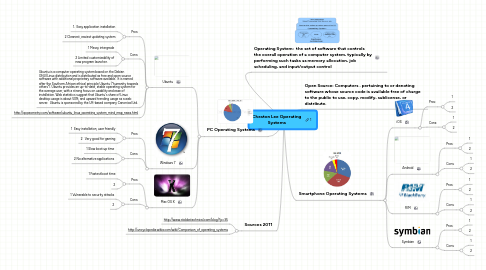
1. Operating System: the set of software that controls the overall operation of a computer system, typically by performing such tasks as memory allocation, job scheduling, and input/output control
2. PC Operating Systems
2.1. Ubuntu
2.1.1. Pros:
2.1.1.1. 1. Easy application installation
2.1.1.2. 2 Cleanest, easiest updating system
2.1.2. Cons:
2.1.2.1. 1 Messy intergrade
2.1.2.2. 2 Limited customizability of new program launcher.
2.1.3. Ubuntu is a computer operating system based on the Debian GNU/Linux distribution and is distributed as free and open source software with additional proprietary software available. It is named after the Southern African ethical principle Ubuntu ("humanity towards others"). Ubuntu provides an up-to-date, stable operating system for the average user, with a strong focus on usability and ease of installation. Web statistics suggest that Ubuntu's share of Linux desktop usage is about 50%, and upward trending usage as a web server. Ubuntu is sponsored by the UK-based company Canonical Ltd.
2.1.4. http://gogeometry.com/software/ubuntu_linux_operating_system_mind_map_news.html
2.2. Windows 7
2.2.1. Pros:
2.2.1.1. 1 Easy installation, user friendly
2.2.1.2. 2 Very good for gaming
2.2.2. Cons:
2.2.2.1. 1 Slow boot up time
2.2.2.2. 2 No alternative applications
2.3. Mac OS X
2.3.1. Pros:
2.3.1.1. 1 Fastest boot time
2.3.1.2. 2
2.3.2. Cons:
2.3.2.1. 1 Vulnerable to security attacks
2.3.2.2. 2
3. Sources 2011
3.1. http://www.stobbstechnical.com/blog/?p=35
3.2. http://uncyclopedia.wikia.com/wiki/Comparison_of_operating_systems
4. Open Source: Computers . pertaining to or denoting software whose source code is available free of charge to the public to use, copy, modify, sublicense, or distribute.
5. Smartphone Operating Systems
5.1. iOS
5.1.1. Pros:
5.1.1.1. 1
5.1.1.2. 2
5.1.2. Cons:
5.1.2.1. 1
5.1.2.2. 2
5.2. Android
5.2.1. Pros:
5.2.1.1. 1
5.2.1.2. 2
5.2.2. Cons:
5.2.2.1. 1
5.2.2.2. 2
5.3. RIM
5.3.1. Pros:
5.3.1.1. 1
5.3.1.2. 2
5.3.2. Cons:
5.3.2.1. 1
5.3.2.2. 2
5.4. Symbian
5.4.1. Pros:
5.4.1.1. 1
5.4.1.2. 2
5.4.2. Cons:
5.4.2.1. 1
5.4.2.2. 2
